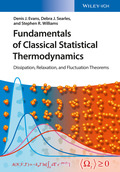Fundamentals of Classical Statistical Thermodynamics
Dissipation, Relaxation and Fluctuation Theorems

1. Auflage Juni 2016
XIV, 205 Seiten, Hardcover
100 Abbildungen
Lehrbuch
Kurzbeschreibung
Both a comprehensive overview and a treatment at the appropriate level of detail, this textbook explains thermodynamics and generalizes the subject so it can be applied to small nano- or biosystems, arbitrarily far from or close to equilibrium.
Both a comprehensive overview and a treatment at the appropriate level of detail, this textbook explains thermodynamics and generalizes the subject so it can be applied to small nano- or biosystems, arbitrarily far from or close to equilibrium. In addition, nonequilibrium free energy theorems are covered with a rigorous exposition of each one. Throughout, the authors stress the physical concepts along with the mathematical derivations.
For researchers and students in physics, chemistry, materials science and molecular biology, this is a useful text for postgraduate courses in statistical mechanics, thermodynamics and molecular simulations, while equally serving as a reference for university teachers and researchers in these fields.
2 INTRODUCTION TO TIME-REVERSIBLE, THERMOSTATTED DYNAMICAL SYSTEMS, AND STATISTICAL MECHANICAL ENSEMBLES
2.1 Time Reversibility in Dynamical Systems
2.2 Introduction to Time-Reversible, Thermostatted Dynamical Systems
2.3 Example: Homogeneously Thermostatted SLLOD Equations for Planar Couette Flow
2.4 Phase Continuity Equation
2.5 Lyapunov Instability and Statistical Mechanics
2.6 Gibbs Entropy in Deterministic Nonequilibrium Macrostates
2.A Appendix: Phase Space Expansion Calculation
3 THE EVANS-SEARLES FLUCTUATION THEOREM
3.1 The Transient Fluctuation Theorem
3.2 Second Law Inequality
3.3 Nonequilibrium Partition Identity
3.4 Integrated Fluctuation Theorem
3.5 Functional Transient Fluctuation Theorem
3.6 The Covariant Dissipation Function
3.7 The Definition of Equilibrium
3.8 Conclusion
4 THE DISSIPATION THEOREM
4.1 Derivation of the Dissipation Theorem
4.2 Equilibrium Distributions are Preserved by Their Associated Dynamics
4.3 Broad Characterization of Nonequilibrium Systems: Driven, Equilibrating, and T-Mixing Systems
5 EQUILIBRIUM RELAXATION THEOREMS
5.1 Introduction
5.2 Relaxation toward Mixing Equilibrium: The Umbrella Sampling Approximation
5.3 Relaxation of Autonomous Hamiltonian Systems under T-Mixing
5.4 Thermal Relaxation to Equilibrium: The Canonical Ensemble
5.5 Relaxation to Quasi-Equilibrium for Nonergodic Systems
5.6 Aside: The Thermodynamic Connection
5.7 Introduction to Classical Thermodynamics
5.A Appendix: Entropy Change for a Cyclic Temperature Variation
6 NONEQUILIBRIUM STEADY STATES
6.1 The Physically Ergodic Nonequilibrium Steady State
6.2 Dissipation in Nonequilibrium Steady States (NESSs)
6.3 For T-Mixing Systems, Nonequilibrium Steady-State Averages are Independent of the Initial Equilibrium Distribution
6.4 In the Linear Response Steady State, the Dissipation is Minimal with
Respect to Variations of the Initial Distribution
6.5 Sum Rules for Dissipation in Steady States
6.6 Positivity of Nonlinear Transport Coefficients
6.7 Linear Constitutive Relations for T-Mixing Canonical Systems
6.8 Gaussian Statistics for T-Mixing NESS
6.9 The Nonequilibrium Steady-State Fluctuation Relation
6.10 Gallavotti-Cohen Steady-State Fluctuation Relation
6.11 Summary
7 APPLICATIONS OF THE FLUCTUATION, DISSIPATION, AND RELAXATION THEOREMS
7.1 Introduction
7.2 Proof of the Zeroth "Law" of Thermodynamics
7.3 Steady-State Heat Flow
7.4 Dissipation Theorem for a Temperature Quench
7.5 Color Relaxation in Color Blind Hamiltonian Systems
7.6 Instantaneous Fluctuation Relations
7.7 Further Properties of the Dissipation Function
8 NONEQUILIBRIUM WORK RELATIONS, THE CLAUSIUS INEQUALITY, AND EQUILIBRIUM THERMODYNAMICS
8.1 Generalized Crooks Fluctuation Theorem (GCFT)
8.2 Generalized Jarzynski Equality (GJE)
8.3 Minimum Average GeneralizedWork
8.4 NonequilibriumWork Relations for CyclicThermal Processes
8.5 Clausius' Inequality, the Thermodynamic Temperature, and Classical Thermodynamics
8.6 Purely Dissipative GeneralizedWork
8.7 Application of the Crooks Fluctuation Theorem (CFT), and the Jarzynski Equality (JE)
8.8 Entropy Revisited
8.9 For Thermostatted Field-Free Systems, the Nonequilibrium Helmholtz Free Energy is a Constant of the Motion
9 CAUSALITY
9.1 Introduction
9.2 Causal and Anti-causal Constitutive Relations
9.3 Green-Kubo Relations for the Causal and Anti-causal Response Functions
9.4 Example: The Maxwell Model of Viscosity
9.5 Phase Space Trajectories for Ergostatted Shear Flow
9.6 Simulation Results
9.7 Summary and Conclusion
up his present appointment. Professor Evans has authored ~300 scientific publications and two research monographs. He has received numerous scientific awards, including the Boys-Rahman Lectureship of the Royal Society of Chemistry (London), and the David Craig medal
of the Australian Academy of Sciences. He is also a Fellow of the Australian Academy of Sciences.
Debra J. Searles received her PhD in Chemistry from the University of Newcastle, Australia. She held postdoctoral research positions at University of Basel, Switzerland, The Australian National University and University of Queensland, Australia. She joined Griffith University in 2000, becoming professor in 2009 and moved to the University of Queensland in 2012 where she has appointments in the Australian Institute for Bioengineering and Nanotechnology and the School of Chemistry and Molecular Biosciences. Since 2013 she has been Director of
the AIBN Centre for Theoretical and Computational Molecular Science. She has 140 publications and is a Fellow of the Royal Australian Chemical Institute.
Stephen R. Williams received his PhD in Physics from RMIT University in Melbourne. He was a postdoc at Utrecht University and has been at the Australian National University since 2003 where he is currently a Senior Research Fellow.


